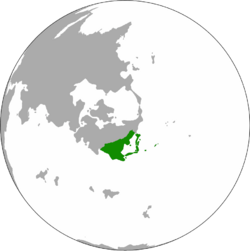Majisia
This article is incomplete because it is pending further input from participants, or it is a work-in-progress by one author. Please comment on this article's talk page to share your input, comments and questions. Note: To contribute to this article, you may need to seek help from the author(s) of this page. |
The State of Majisia ᮔᮃᮌᮃᮛᮃ ᮙᮃᮏᮃᮞᮤᮃ Nagara Majasia | |
|---|---|
| Motto: ᮙᮃᮜᮃᮌ ᮞᮤᮔᮃ ᮙᮃᮧᮒ, ᮔᮌᮃᮠᮤᮏᮤ "Malah Dina Maot, Ngahiji" "Even in Death, United" | |
| Anthem: ᮕᮃᮔᮧᮔᮕᮧᮆ ᮏᮨᮥᮔᮌ ᮘᮥᮜᮃᮔ Panonpoé jeung Bulan Sun and Moon | |
 Location of Majisia in Isuan (green) | |
| Capital and largest city | Nyawlbitang |
| Official languages | Majisian |
| Recognised regional languages | Kakawin Bansunese Songhese Tyrnican |
| Ethnic groups (2020) | Majisian 85% Trenggulunese 5% Bansunese 5% Songhese 4.5% Tyrnican 0.5% |
| Demonym(s) | Majisian |
| Government | Unitary One-Party Semi-Presidential Republic |
| Nunung Omoh | |
• Premier | Elan Kur |
| Dayat Achol | |
| Legislature | National Consultative Assembly |
| Independence from Tyrnica | |
• Protectorate of Majisia | 12 April 1895 |
• Kingdom of Majisia's independence | 1913 |
| 20 May 1922 | |
• Proclamation of Majisia | 9 January 1924 |
| Population | |
• 2023 estimate | 49,768,672 |
• 2020 census | 49,250,481 |
| GDP (PPP) | estimate |
• Total | |
• Per capita | |
| GDP (nominal) | estimate |
• Total | |
• Per capita | |
| Gini (2020) | 34.7 medium |
| HDI (2020) | medium |
| Currency | Majisian Vlyesi (ᮗᮜ) (MVL) |
| Driving side | left |
| Calling code | +818 |
| ISO 3166 code | MJ |
| Internet TLD | .maj |
Majisia, officially the State of Majisia (Majisian: ᮔᮃᮌᮃᮛᮃ ᮙᮃᮏᮃᮞᮤᮃ) is a sovereign state located in Isuan. It is bordered by Songha, Bansunay, and Trenggulun to the north, and by the Demontean Ocean to the south. Majisia consists of eleven islands and a mainland, with the majority of the population residing on the mainland. Majisia has a population of 49.2 million. The nation's capital and largest city is Nyawlbitang, which is among some of the largest urban centers in Isuan. Other major cities include Manorong, Lubukgarong, and Matabang.
Evidence of ancient humans found in Majisia dates back to 10,000 BCE. The first evidence of societies within Majisia dates back to 300 BCE. For much of it's early history, the area now constituting Majisia in Isuan consisted of multiple Trenggulunese, Majisian, and Bansunese city-states and tribes. Trenggulunese city-states controlled much of Majisia's coastline from (date) to (date). These tribal entities dominated the region until the 1700s, when colonization by Tyrnica placed much of Isuan under Auressian influence. Majisia became a protectorate of Tyrnica in 1895 and participated in the First Great War in limited capacity. After the signing of the Treaty of Arden in 1913, Majisia became independent, forming the Kingdom of Majisia. Majisia's monarchy retained many western ties, and anger amongst the populace resulted in the Black Revolution in 1922 which forced out the ruling constitutional monarchy in favor of a one-party system. Majisia then joined the Alliance of Songha and supported their forces in the Second Great War. Majisian forces battled the Coalition in Isuan and surrounding areas; though Majisia never occupied any territory for itself. After surrendering in 1943, Majisia was occupied by Coalition forces until 1948.
The 1950s and 1960s saw Majisia begin to rebuild and refine itself as a nation; however, the Grand Party of Majisians and it's Supreme Leader struggled to find footing between an isolationist attitude and economic opportunity. Beginning in the 1970s, the government began initiatives to increase tourism and international trade, resulting in an economic boom in the 1980s and 1990s. Since then, Majisia has become a fairly popular tourist destination and important exporter within Levilion.
Governed by a Unitary One-Party system, the Grand Party of Majisians is the sole legal political movement in the nation. All other political entities are banned according to Article 3 of the state constitution. Ultimate authority is vested in the Supreme Leader; the position has been held by Nunung Omoh since 2013. The Majisian government is authoritarian, and has attracted widespread criticism for it's restrictions of human rights and civil liberties. Although Majisia does not institute discrimination against women or children, many minorities do not recieve the same opportunities as ethnic Majisians. Mass protests are suppressed, elections are unfairly rigged, and militarism and nationalism are heavily promoted. While state-owned or funded entities do exist, private ownership in Majisia is allowed, differentiating it from socialist states.
Majisia is known for it's rich culture, vibrant festivals, lush tropical environments, and myriad of ancient traditions and art forms. Majisia is considered a middle power within Isuan, with average or slightly above average economic and military power. The Majisian Armed Forces make up the country's military and consists of the Army of Majisians, the Majisian Navy, the Majisian Aero Force, the Majisian Coast Guard, and the Revolutionary Guard. A citizen of Majisia is called a "Majisian".

